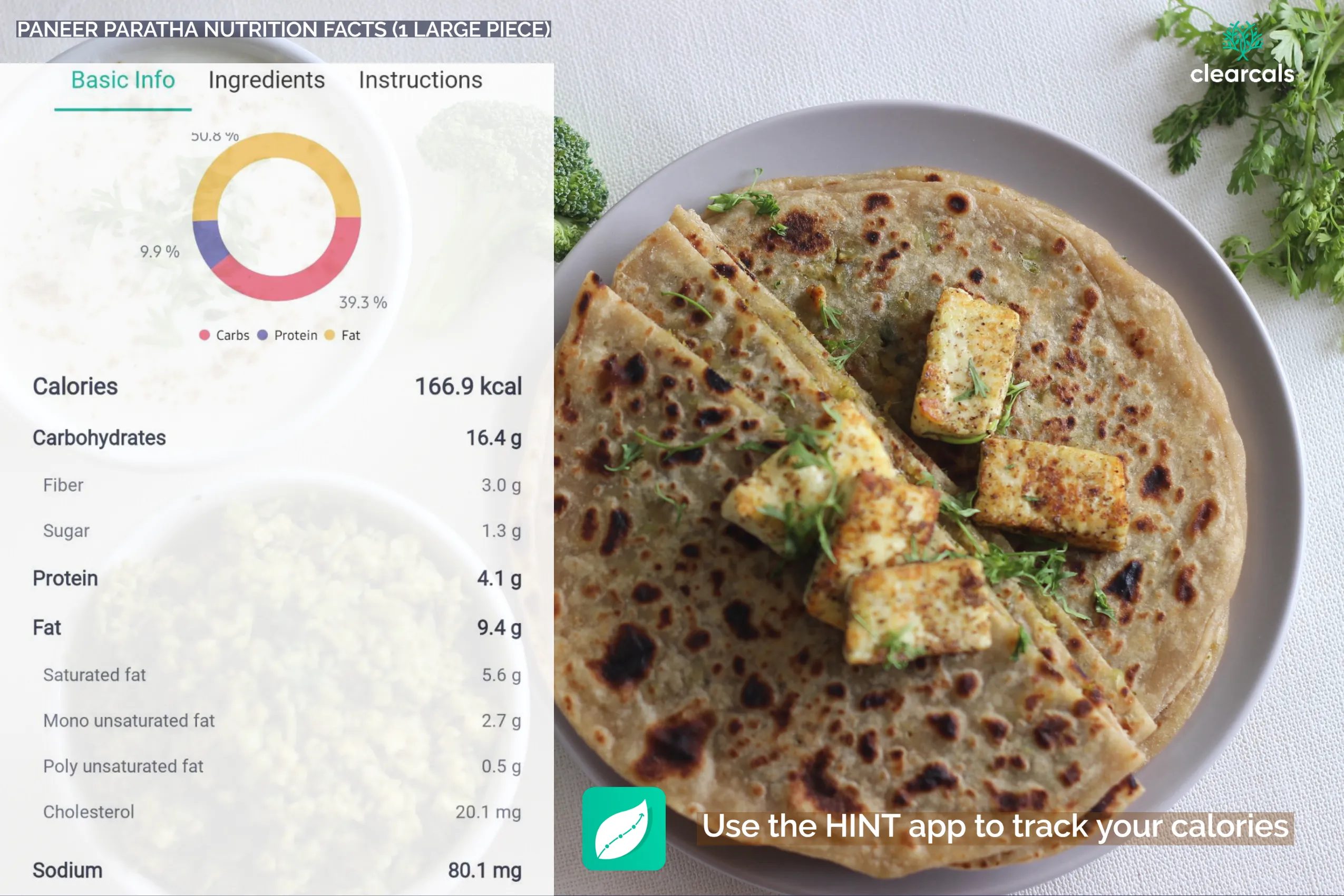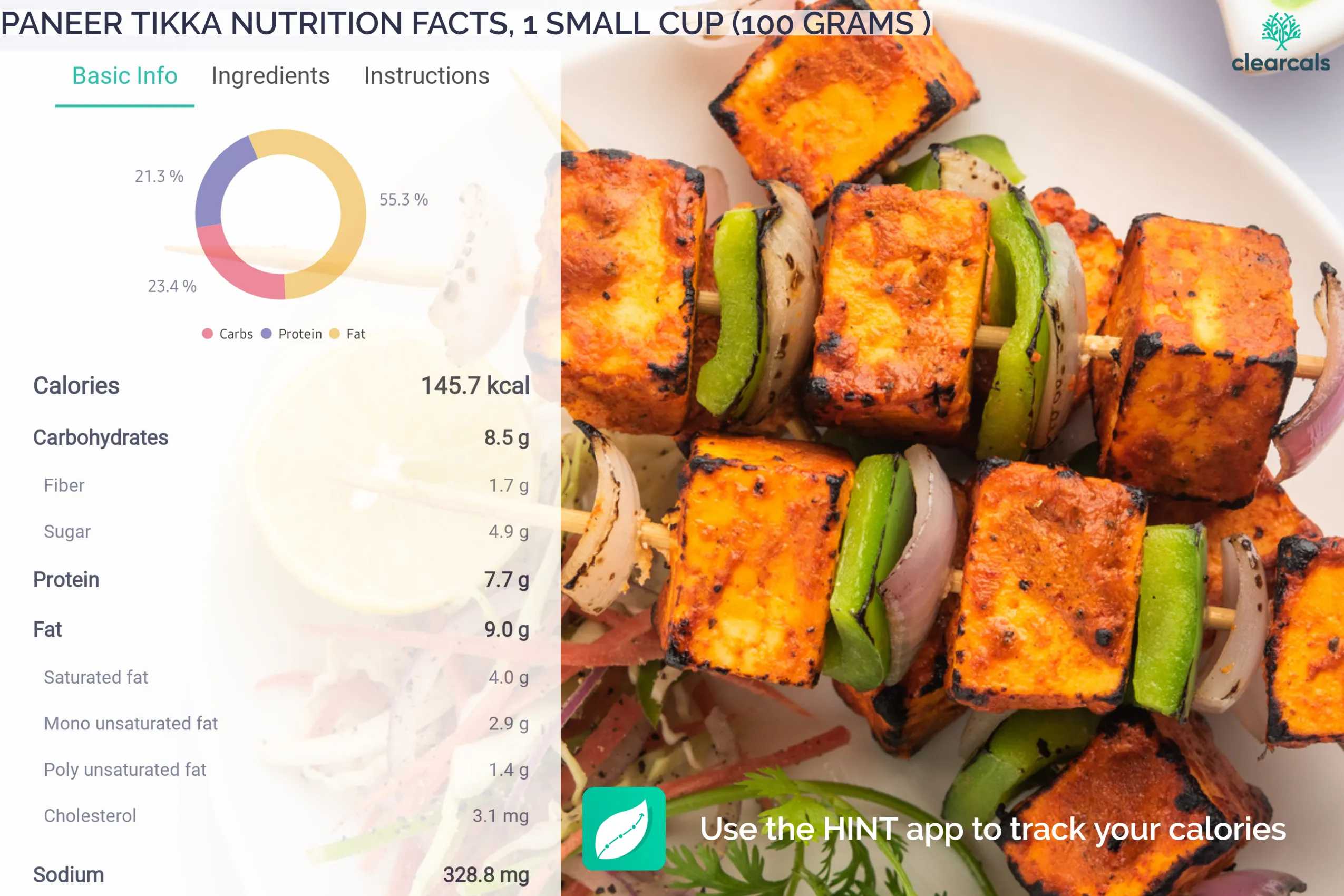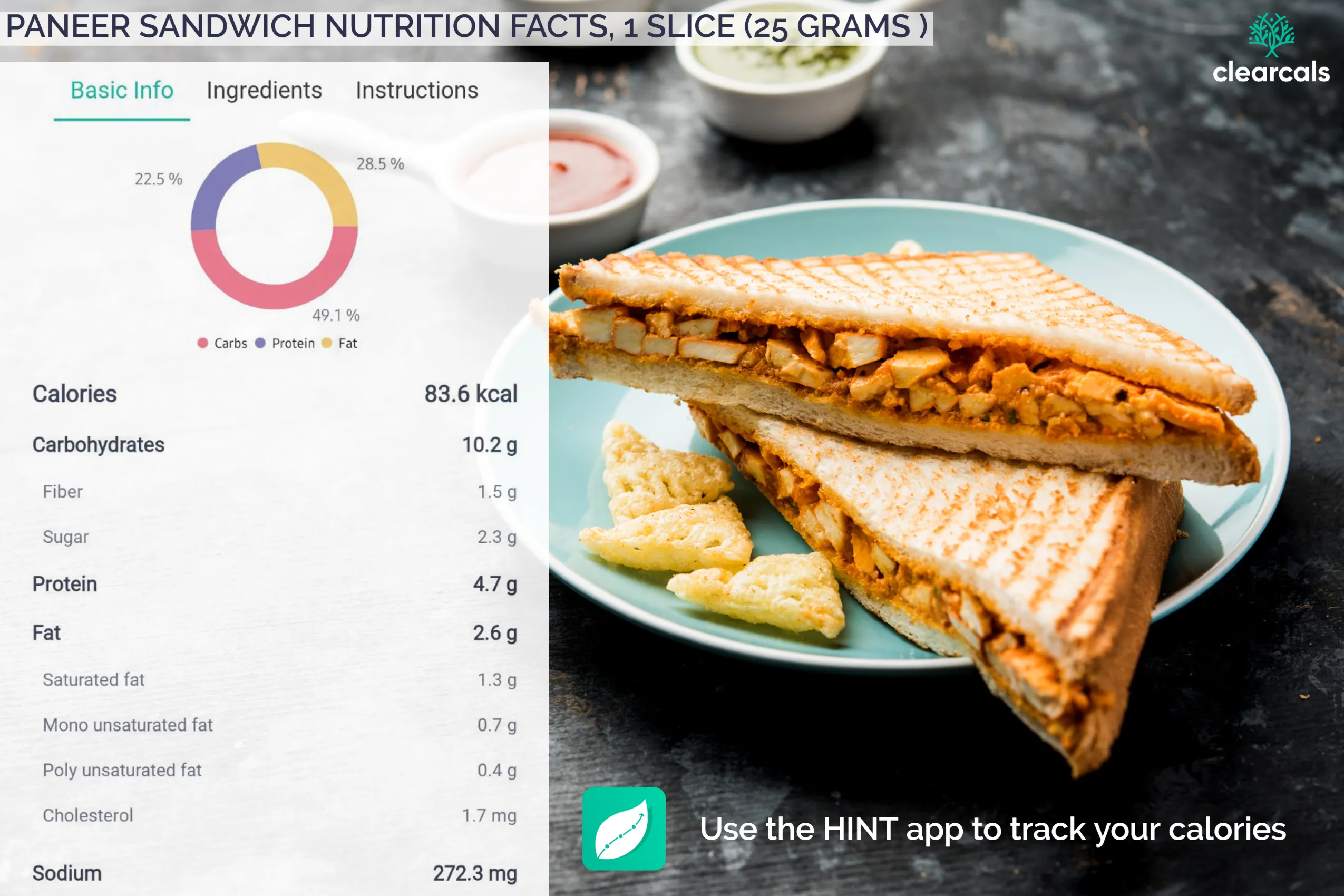Looking for a Personalized Diet Plan?
Paneer Calories, Nutrition and Health Benefits

By Asfia Fatima, Chief Dietitian at Clearcals
TL;DR
- 100 grams of paneer contains 258 Calories.
- Paneer is a rich source of protein, calcium, and various essential nutrients.
- Paneer can aid in weight loss, muscle gain, and managing diabetes, but it should be consumed in moderation due to its fat content.
- Track your calories and nutrients from paneer using the Hint app.
How Many Calories Are in 100 Grams of Paneer?
100 grams of paneer provides 258 kcal. The calories in paneer depend on its serving size or quantity in grams. Here is a table of how calories increase with quantity.
| Quantity | Paneer Calories (kcal) |
|---|---|
| 50 grams | 129 |
| 100 grams | 258 |
| 150 grams | 387 |
| 200 grams | 516 |
| 250 grams | 645 |
| 300 grams | 774 |
| 350 grams | 903 |
| 400 grams | 1032 |
| 450 grams | 1161 |
| 500 grams | 1290 |
| 1 kg | 2581 |
Download the Hint app to track your calories and nutrition from paneer dishes and other meals.
Watch: How to Track Paneer Calories on the Hint App
Paneer Nutrition
Paneer is not only a rich source of protein but also contains essential micronutrients like calcium, phosphorus, selenium, and zinc.
It provides 19% carbohydrates, 29% protein, and 52% fat. These nutrients make paneer beneficial for bone health, muscle function, and immunity.
With Hint Pro, you can personalize your diet and track your intake of key nutrients like protein, fat, and calcium to meet your specific health goals.
Protein in Paneer
Paneer is an excellent source of protein, providing around 19 grams of protein per 100 grams. This makes it an ideal food for muscle growth, recovery, and overall health.
Here is a table of how the protein in paneer increases with quantity.
| Quantity | Paneer Protein (grams) |
|---|---|
| 50 grams | 9.4 |
| 100 grams | 18.9 |
| 150 grams | 28.3 |
| 200 grams | 37.8 |
| 250 grams | 47.2 |
| 300 grams | 56.7 |
| 350 grams | 66.1 |
| 400 grams | 75.6 |
| 450 grams | 85.0 |
| 500 grams | 94.5 |
| 1 kg | 189 |
Whether you're aiming to build muscle or simply increase your protein intake, paneer is a versatile food that can help meet your protein goals.
The Hint app offers high-protein recipe suggestions to further enhance your meal plan.

Fat in Paneer
Paneer contains approximately 15 grams of fat per 100 grams, which contributes to its rich, creamy texture. While it’s high in fats, most of them are good fats, including conjugated linoleic acid (CLA), which helps in fat loss.
However, paneer is also high in saturated fats, so it's important to consume it in moderation.
You can use the Hint app to track your fat intake and maintain a balanced diet, especially if you're watching your cholesterol or weight.
Is Paneer Good for Health?
Yes, paneer is a nutrient-dense food that provides essential vitamins and minerals. It supports bone health due to its high calcium content and helps maintain muscle mass due to its protein.
Paneer is also beneficial for heart health when consumed in moderation, as its healthy fats and micronutrients like selenium help reduce inflammation.
The Hint Pro subscription offers personalized health insights, helping you incorporate paneer into your diet in a balanced way.
Paneer Benefits
- Weight Loss: Although high in fats, paneer’s rich protein content promotes satiety, making it a great option for weight loss when eaten in moderation.
- Muscle Gain: Paneer is an excellent source of protein, which is essential for muscle repair and growth.
- Diabetes Management: Paneer has a low glycemic index, meaning it doesn’t cause rapid spikes in blood sugar levels.
- Bone Health: Packed with calcium, phosphorus, and magnesium, paneer supports strong bones and teeth.
- Immunity Boost: Paneer contains zinc, selenium, and protein, which are essential for boosting the immune system.
Track your health benefits from paneer and other foods with the Hint app, and consult with dietitians through Hint Premium for expert advice.
Is paneer fat or protein?
Paneer is rich in both protein and fat, but its exact ratio depends on the type of milk used and how it’s prepared.
- Full-fat paneer (made from whole milk) contains more fat, making it calorie-dense and suitable for muscle gain or keto diets.
- Low-fat paneer (made from toned or skim milk) has a higher protein-to-fat ratio and is better for weight loss.
To know the exact fat and protein in your homemade paneer, use the Hint app and log your recipe using the “Create Your Recipe” feature.
Is Paneer Good for Cholesterol?
Paneer contains both healthy fats and saturated fats. While it can raise cholesterol levels if consumed in excess, moderate consumption, especially when paired with fiber-rich vegetables, can help balance cholesterol levels.
For people managing cholesterol, the Hint app can help track your saturated fat intake and ensure you’re making heart-healthy food choices.
Is paneer good for weight loss?
Paneer is rich in protein, which helps you feel full longer, preventing overeating and aiding in weight loss. Although it is high in fat, the type of fats in paneer can support metabolism and fat burning when consumed in moderation.
Pairing paneer with fiber-rich foods like salads can create a balanced meal that promotes weight loss.
The Hint app provides tailored meal plans to help you achieve your weight loss goals.
Is paneer good for diabetes?
Paneer has a low glycemic index, meaning it doesn’t cause significant spikes in blood sugar.
Its high protein content and healthy fats also help stabilize blood sugar levels, making it a good option for people with diabetes.
Use the Hint app to find diabetic-friendly recipes and track your carb intake to manage your blood sugar effectively.
Is paneer good for blood pressure?
The sodium content in paneer is very low and hence helps in controlling blood pressure. The calcium, phosphorus, and potassium levels in the paneer help in restoring electrolyte balance and maintaining blood pressure.
However, one shouldn’t go overboard as it is high in saturated fat.
Is paneer good for PCOS?
Paneer is high in fat and calories, which may interfere with ovarian function; hence not a good choice for PCOS. To learn more about the PCOS diet and treatment, read our blog.
Is paneer good for the thyroid?
Paneer is an excellent source of selenium, a mineral that plays a critical role in thyroid health. Selenium supports the production of thyroid hormones and helps reduce oxidative stress.
Consuming selenium-rich foods like paneer can help maintain proper thyroid function.
With Hint Premium, you can consult with expert dietitians to optimize your diet for thyroid health.
Is paneer good for immunity?
Paneer contains reasonable amounts of essential nutrients, is a good source of zinc and pantothenic acid, and is an excellent source of protein, biotin, calcium, phosphorus, and selenium, which helps in boosting immunity.
To know how these nutrients effectively boost immunity, read our blog on supporting your immunity through nutrition.

Is paneer good for muscle gain?
Paneer’s high protein content makes it an ideal choice for muscle gain. It provides essential amino acids that help in muscle repair and growth, especially when combined with resistance training.
The Hint app allows you to track your protein intake and provides high-protein meal ideas to optimize muscle growth.
Is paneer good for weight gain?
Paneer contains high amounts of protein, which makes you feel satiated quickly as it is slowly digested. Hence, it is not considered a good choice for weight gain.
Is paneer good for fat loss?
Paneer contains conjugated linoleic acid (CLA), a fatty acid known to aid in fat loss. Its high protein content promotes fat burning and muscle retention during weight loss.
For those focusing on fat loss, the Hint app can help you monitor your calorie intake and track your macronutrients to meet your fitness goals.
Is Paneer Good for the Fatty Liver?
Paneer, being high in protein and low in carbohydrates, can help manage fatty liver conditions when eaten in moderation.
Healthy fats support liver function, but individuals with fatty liver disease should monitor their saturated fat intake.
The Hint app helps you track your fat consumption to ensure you’re eating in a way that supports liver health.
Calorie and Nutrition Facts of Various Paneer Recipes
Calories in a paneer dish depend on the recipe, serving size, or quantity in grams. Always eat paneer in moderation as it is high in fat.
Here are the calorie values of various types of paneer recipes for one small cup (100 grams).
| Paneer Recipes | Calories (kcal) in one small cup (100 grams) |
|---|---|
| Paneer capsicum curry | 93 |
| Paneer do pyaza | 108 |
| Paneer pasanday | 114 |
| Paneer biryani | 126 |
| Kadai paneer | 130 |
| Stir fried paneer salad | 132 |
| Shahi paneer | 143 |
| Paneer tikka | 146 |
| Palak paneer | 147 |
| Methi paneer curry | 148 |
| Matar paneer | 153 |
| Paneer Peshawari | 159 |
| Paneer korma | 161 |
| Paneer makhanwala | 163 |
| Paneer bhurji | 174 |
| Paneer makhani | 176 |
| Paneer kolhapuri | 178 |
| Paneer kali mirch | 182 |
| Paneer peas bhurji | 187 |
| Paneer kheer | 215 |
| Paneer onion bhurji | 217 |
| Paneer butter masala | 220 |
| Paneer Chettinad | 230 |
| Grilled paneer | 280 |
Download the Hint app for more information on healthy paneer recipes, calories, and nutrition facts.

1. Butter paneer masala calories
One small cup of butter paneer masala has 219 kcal. It contains 18% carbohydrates, 20% protein, and 62% of fat. Paneer butter masala is a good source of vitamin K, vitamin D, and manganese. It is an excellent source of protein, biotin, calcium, phosphorus, and selenium.
The calories in butter paneer masala depend on its serving size or quantity in grams. Here is a table of how calories increase with quantity.
| Quantity (In grams) | Butter paneer masala calories (kcal) |
|---|---|
| 1 Small cup (100 grams) | 219 |
| 1 Medium cup (200 grams) | 438 |
| 1 Large cup (300 grams) | 656 |

2. Paneer paratha calories
One large piece (50 grams) of paneer paratha contains 167 kcal. It contains 39% carbohydrates, 10% protein, and 51% fat. Paneer paratha is a good source of dietary fiber, manganese, lutein, and phosphorus, and is an excellent source of selenium and vitamin D. Eat this in moderation as it is high in saturated fat.
Here is a list of how calories increase with quantity (serving size) and the number of paneer parathas.
| Paratha Size (in grams) | 1 Paratha Calories (kcal) | 2 Paratha Calories (kcal) | 3 Paratha Calories (kcal) | 4 Paratha Calories (kcal) |
|---|---|---|---|---|
| Small piece (30 grams) | 100 | 200 | 301 | 401 |
| Medium piece (40 grams) | 134 | 267 | 401 | 534 |
| Large piece (50 grams) | 167 | 334 | 500 | 668 |

3. Paneer tikka calories
One small cup of paneer tikka has 146 kcal. It contains 23% carbohydrates, 21% protein, and 55% fat. Paneer tikka is a good source of protein, folate, vitamin E, calcium, and phosphorus. It is an excellent source of selenium and vitamin C.
The calories in paneer tikka depend on its serving size or quantity in grams. Here is a table of how calories increase with quantity.
| Quantity (In grams) | Paneer tikka calories (kcal) |
|---|---|
| 1 Small cup (100 grams) | 146 |
| 1 Medium cup (200 grams) | 291 |
| 1 Large cup (300 grams) | 437 |

4. Palak paneer calories
One small cup of palak paneer has 145 kcal. It contains 21% carbohydrates, 20% protein, and 59% fat. Palak paneer is a good source of protein, potassium, dietary fiber, folate, vitamin C, vitamin D, phosphorus, magnesium, copper, vitamin E, and manganese, and an excellent source of calcium, selenium, biotin, beta carotene, and lutein.
The calories in palak paneer depend on its serving size or quantity in grams. Here is a table of how calories increase with quantity.
| Quantity (In grams) | Palak paneer calories (kcal) |
|---|---|
| 1 Small cup (100 grams) | 145 |
| 1 Medium cup (200 grams) | 291 |
| 1 Large cup (300 grams) | 436 |

5. Paneer bhurji calories
One small cup of paneer bhurji has 173 kcal. It contains 24% carbohydrates, 23% protein, and 53% fat. Paneer bhurji is a good source of protein, folate, vitamin C, vitamin E, and phosphorus, and an excellent source of biotin, calcium, selenium, and vitamin D.
The calories in paneer bhurji depend on its serving size or quantity in grams. Here is a table of how calories increase with quantity.
| Quantity (In grams) | Paneer bhurji calories (kcal) |
|---|---|
| 1 Small cup (100 grams) | 173 |
| 1 Medium cup (200 grams) | 347 |
| 1 Large cup (300 grams) | 520 |

6. Paneer sandwich calories
One slice of paneer sandwich has 84 kcal. It contains 49% carbohydrates, 23% protein, and 28% fat. A grilled paneer sandwich is a good source of protein, biotin, selenium, and calcium.
The calories in a paneer sandwich depend on its serving size or quantity in grams. Here is a table of how calories increase with quantity.
| Quantity (In grams) | Paneer sandwich calories (kcal) |
|---|---|
| 1 Slice (25 grams) | 84 |
| 2 Slice (50 grams) | 167 |
| 3 Slice (75 grams) | 251 |

7. Matar paneer calories
One small cup of matar paneer has 153 kcal. It contains 24% carbohydrates, 20% protein, and 56% fat. Mutter paneer curry is a good source of protein, dietary fiber, folate, vitamin C, phosphorus, magnesium, copper, vitamin E, beta carotene, lycopene, lutein, and an excellent source of calcium, selenium, biotin, and vitamin D.
The calories in matar paneer depend on its serving size or quantity in grams. Here is a table of how calories increase with quantity.
| Quantity (In grams) | Matar paneer calories (kcal) |
|---|---|
| 1 Small cup (100 grams) | 153 |
| 1 Medium cup (200 grams) | 306 |
| 1 Large cup (300 grams) | 458 |
Final Thoughts
Paneer is a versatile, protein-rich food that can be part of a healthy diet when consumed in moderation. Its benefits for muscle gain, weight loss, and diabetes management make it a popular choice for those focusing on health and fitness.
However, paneer’s fat content means it should be eaten mindfully, particularly if you're managing cholesterol or trying to lose weight.
With the Hint app, you can easily track your calories, fat, and protein intake from paneer and other foods.
Hint Pro offers tailored meal plans, and Hint Premium provides access to expert dietitians for personalized guidance, ensuring you make the best choices for your health and wellness.
Exclusive Offer: Enjoy One Month of Free Hint Premium Access
When you purchase any of the select Garmin Watches from the Clearcals Store, you'll receive one month of free Hint Premium (worth Rs. 1999), which includes:
✅ Unlimited dietitian consultations
✅ Personalized diet and workout plans
✅ Advanced calorie and nutrition tracking
🚀 Visit the Clearcals Store today and unlock your free Hint Premium access!
About the Author
Asfia Fatima is the Chief Dietitian at Clearcals, with a Master’s Degree in Dietetics and Clinical Nutrition and over a decade of experience in clinical nutrition and lifestyle management.
She specializes in evidence-based diet planning for weight loss, diabetes, and metabolic health.
At Clearcals, she leads the nutrition strategy behind the Hint app, helping users achieve their goals with science-backed guidance.
🔗 Connect with Asfia on LinkedIn






